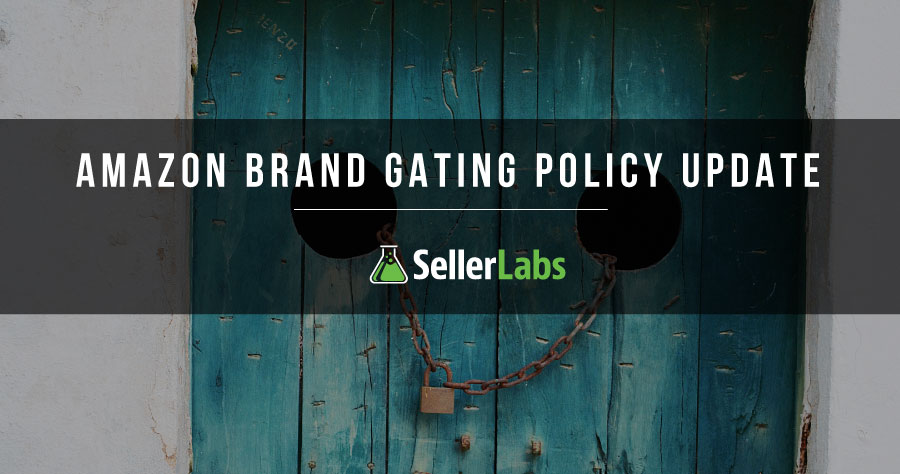Amazon Brand Gating Policy Update
Amazon will now be charging a non-refundable, one-time application fee of $1,000 to $5,000 for third-party merchants to sell popular brands on its site. And even then, merchants aren’t guaranteed access without the necessary documentation proving permission to sell from the brands. Ecommerce Bytes reported on the Amazon brand gating policy update and was able to get a quote from the company about the news, stating:
We want customers to be able to shop with confidence on Amazon. We consider several factors when determining qualifications and criteria to sell certain products. For certain products and categories, Amazon requires additional performance checks, other qualification requirements, and fees.
The news has come with mixed reception.
Brand Gating Winners and Losers?
Winners
- Big brands. This update will give big brands increased confidence to sell their products on Amazon without the threat of counterfeiters and resellers eating into their margins.
- Amazon. The retail giant wants to be “the everything store,” and this update gives Amazon increased legitimacy and latitude. The last thing it wants is large brands to quit—or never start—selling on its site.
- Private Label Sellers. This is especially good news for up-and-coming private label brands that are trying to gain traction on Amazon. Although, it’s not clear whether or not Amazon’s gating policy will trickle down to smaller sellers; hopefully it will allow them to deny hijackers from posting to their listings. Amazon’s Brand Registry program already gives brand owners increased control over their detail pages, why not allow them to gate their listings, too?
- Shoppers. The new policy could bring an influx of brands to Amazon. With Prime two-day shipping, easy checkout and a whole list of added features, this could very well increase the average amount a shopper spends on the site, as well as bringing new shoppers to the site.
- Resellers. The updated policy makes reselling a big-name brand a possibility for new and old resellers alike. If a reseller can get permission to sell a brand and pay the required application fee, then there’s really no reason why they couldn’t sell it on Amazon.
Losers
- Arbitrage/Liquidation Sellers. This news comes as a huge blow to many retail/online arbitrage, and liquidation sellers. So far Nike, Adidas, Legos, Microsoft, Pokemon, Gund, Funko, and many brands in the Toys & Games category have been gated to resellers. Many sellers have expressed their laments on the Amazon Seller Central forum. The full extent of the restrictions and brand gating remains to be seen, but it’s certain to disrupt many businesses.
- Resellers. It appears some resellers will be grandfathered into the new policy, but this will be costly for resellers with permission from a brand to expand their offerings. What’s more, this could prompt brands to gate their listings completely and start selling their own products.
- Amazon…sorta. Amazon’s Marketplace—which enables third-party merchants to sell on its site—is considered one of the company’s three pillars. It’s estimated the company earned $78 billion in 2014, and $131 billion in 2015 from third-party merchants. This brand gating policy update seems like it could directly affect the growth of Amazon Marketplace. But with the cost of the new policy being put on the shoulders of third-party merchants, Amazon should still come out on top. Ultimately, this update reduces the freedom of Marketplace, which means the barrier to entry will be steeper for new sellers.
- Shoppers. Since fewer sellers will be on the site, less competition means fewer product offerings, which means higher prices for shoppers. The race to the bottom will shrink and that’s not good for shoppers looking for the absolute lowest prices.
Combating Counterfeiters
Counterfeit products have cost Amazon hundreds of millions of dollars in profits and brand trust. Just look at what happened to Birkenstocks and how it reacted to counterfeit products sold on Amazon. This is clearly bad for business and Amazon is trying to overhaul its platform to be more brand friendly.
At the company’s inaugural Amazon Marketplace Women’s Entrepreneur Conference this month, an Amazon executive said, “The company will soon release a tool enabling businesses to register their branded products to make it really difficult for counterfeiters and other sellers to exploit.” And if that wasn’t enough, Amazon is projected to release a program to 5,000 top sellers later this year that will call them if it sees an impending problem.
Final Word
Ultimately Amazon’s priority is to satisfy and delight its customers. Vendors, brands, and—especially—third-party merchants are competing against Amazon first-party offerings. It’s their sandbox and sellers have to play by their rules. As the platform evolves, plan on seeing more policy changes and increased competition.
